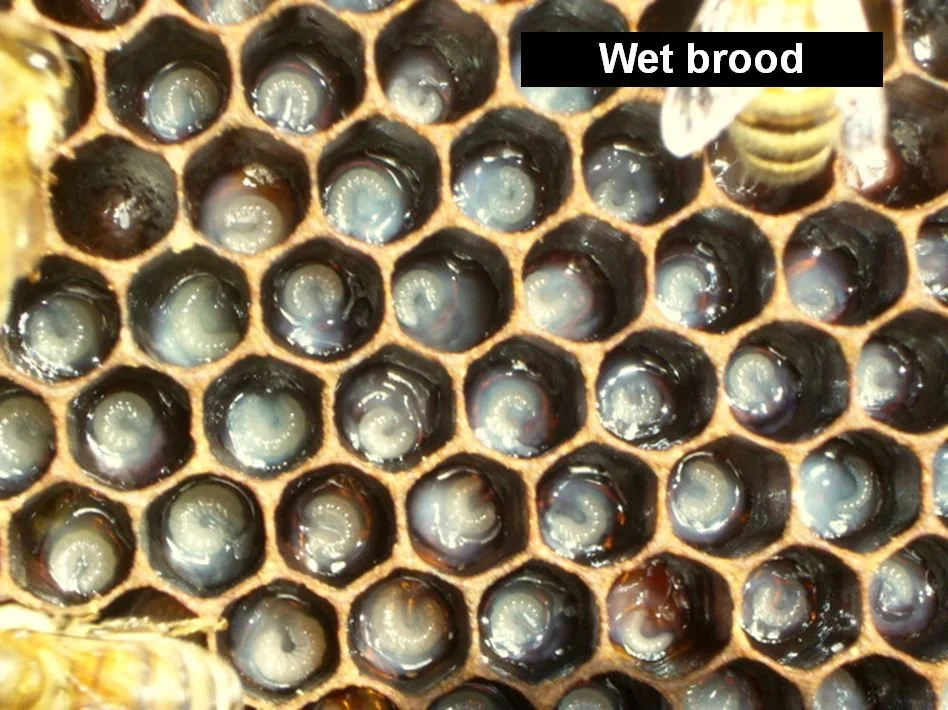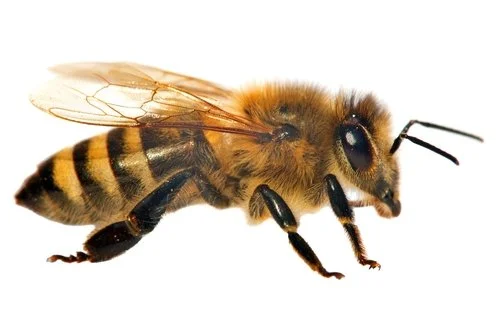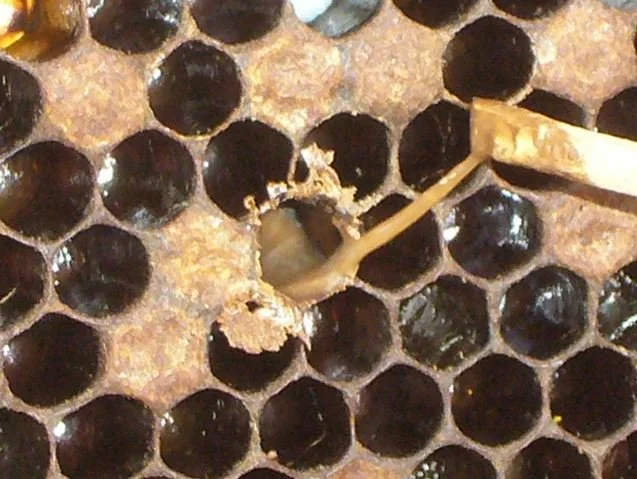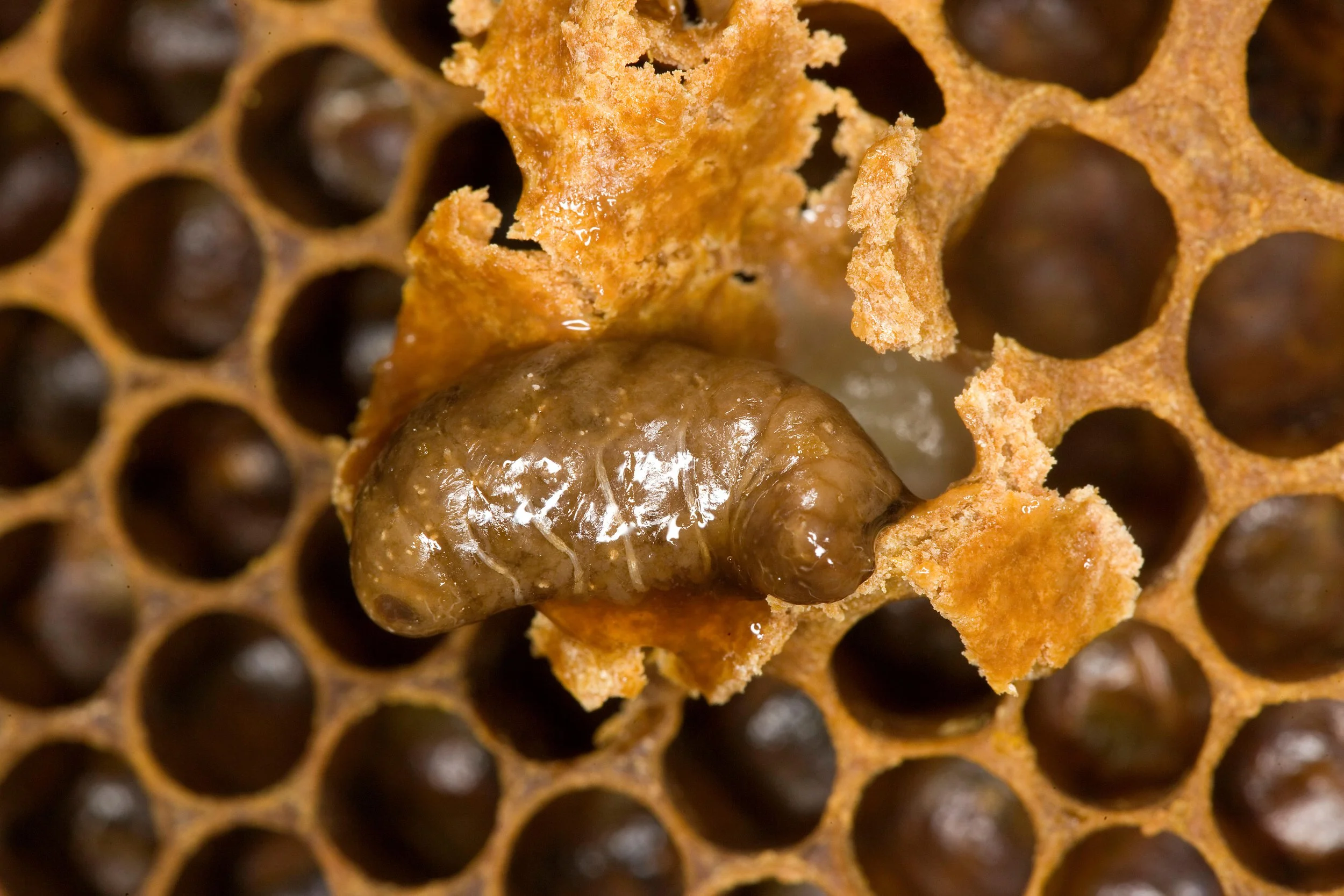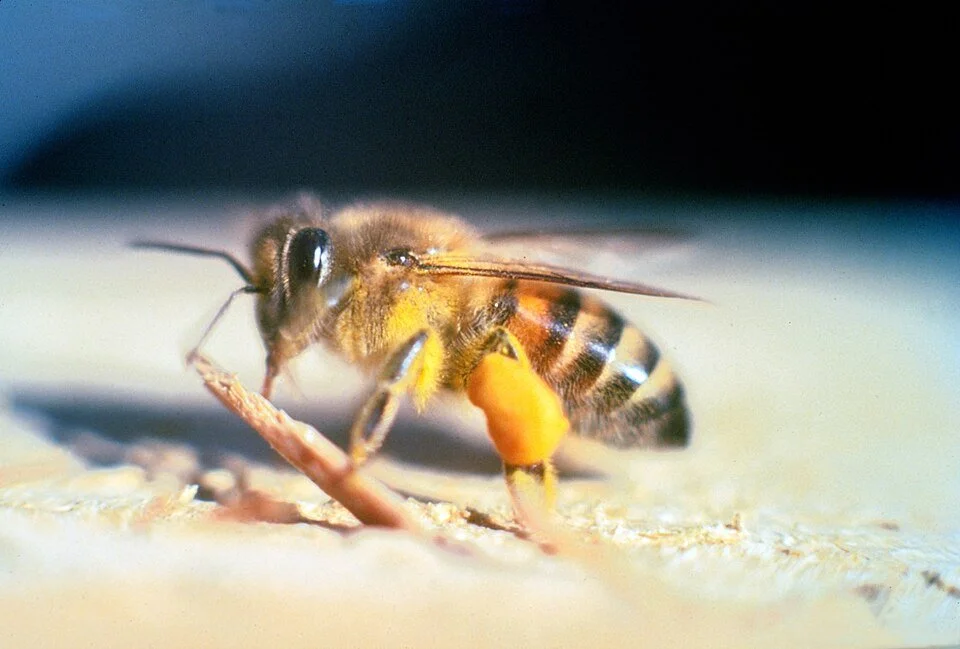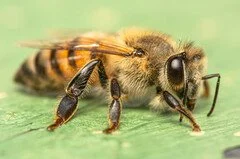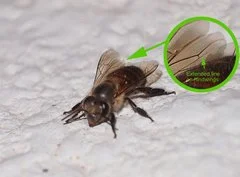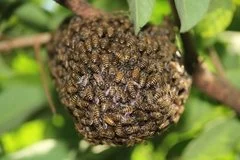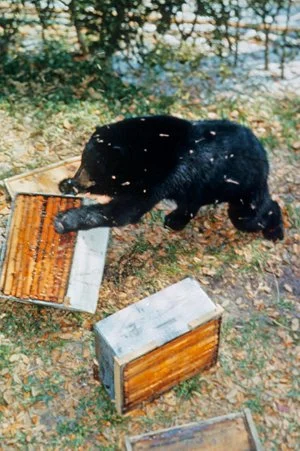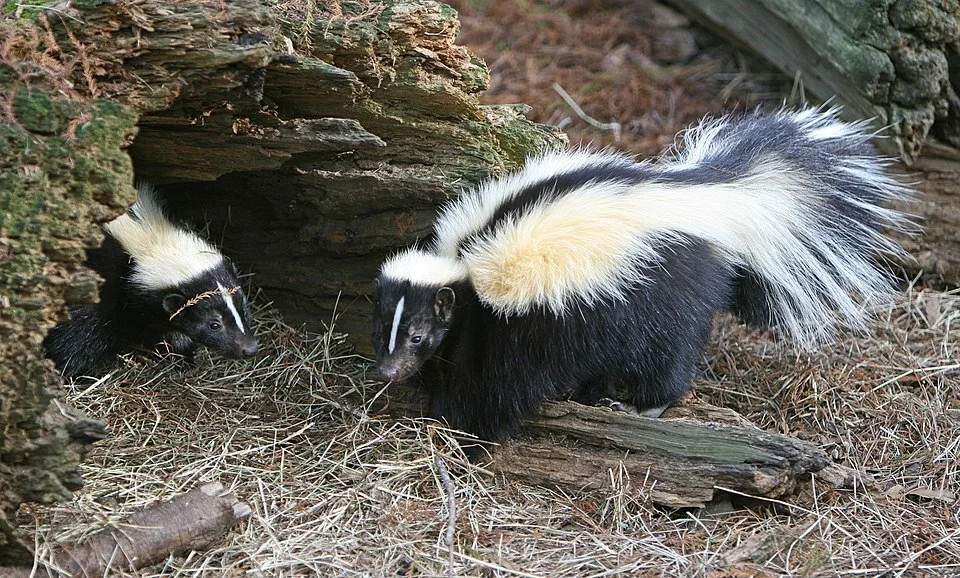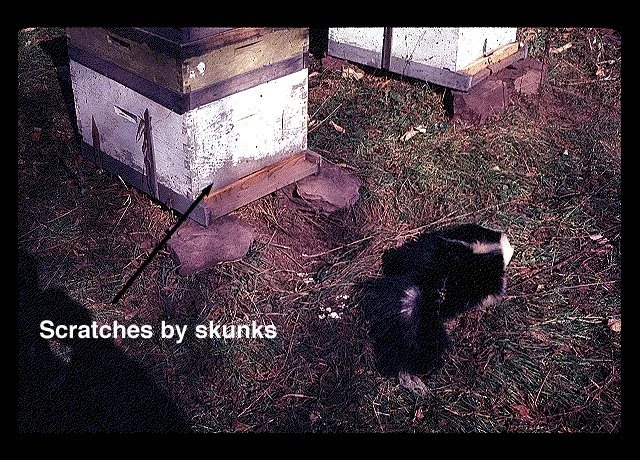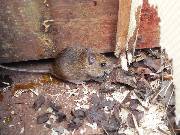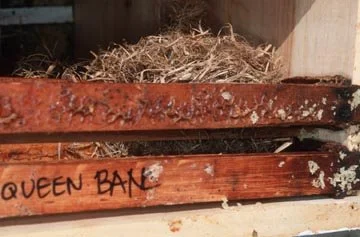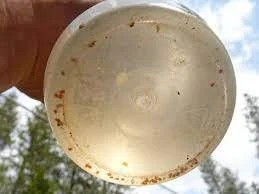There is a strong temptation for new beekeepers to worry that their hive has every bee disease known to humans and then some. The truth of the matter is that honey bees are usually pretty healthy. You are likely to encounter the Varroa mite, so we encourage you to know about them and their life cycle; American Foul Brood is a contagious and reportable bee disease, so you should 1) know that it exists, and 2) know a bit about the symptoms, and 3) know that most beekeepers have never seen it. If you are starting with bees, it is far more essential to know what healthy brood and bees look like. If you think something is off, review the pests and diseases listed here - we’ve tried to include most and provide Maine-specific information where applicable.
This is what healthy looks like:
Randy Oliver - scientifcbeekeeping.com - used with permission
Larvae floating in pools of jelly (food).
licensed by Shutterstock
Capped worker brood surrounded by eggs and larvae.
licensed by Shutterstock
A worker honey bee.
Honey Bee Diseases and Pests
Diseases can be categorized into two classes: those that affect developing bees and those that affect adult bees.
American Foulbrood
Paenibacillus larvae
Randy Oliver - scientifcbeekeeping.com
Brood Disease
American Foul Brood (AFB) is a contagious bacterial disease, the spores of which remain infectious for over 50 years. There are a handful of cases in Maine each year now, primarily attributed to the reuse of long-stored but uninspected equipment. It is a disease that formerly had a much larger incidence in Maine, but now there are usually between two and four outbreaks per year. The State Apiarists (formerly Tony Jadzack and now Jen Lund) deserve much credit for reducing the number of incidents that have taken AFB from the feared category and placed it in the group that requires vigilance and recognition of symptoms.
Randy Oliver - scientifcbeekeeping.com
Randy Oliver - scientifcbeekeeping.com
Website - PennState Extension - American Foul Brood AMAZING PICTURES OF AFB IN VARIOUS STAGES BY EAS MASTER BEEKEEPER STEVEN REPASKY
Web Pages - Bee Aware (Australia) - American Foul Brood
PDF - Honey Bee Health Coalition - Identifying and Mitigating Foulbrood in Honeybee Colonies and Reducing the Use of Antibiotics
Video - Oregon State University Extension - Diagnosing American Foulbrood in Honey Bee Colonies (link is to YouTube)
Fact Sheet - USDA ARS - American Foulbrood Factsheet
Video - David Burns - Beekeeping Nightmare: Be On The Lookout For this Deadly Disease (link is to YouTube)
In Maine, hives infected with American Foulbrood Disease, after a confirming laboratory test, must be destroyed. (both bees and woodenware)
Chalkbrood
Ascophaera Apis
Randy Oliver - scientifcbeekeeping.com
Brood Disease
Chalkbrood is a common issue in Maine. It is a mostly seasonal fungal disease that is related to colony stress. It is not usually fatal to the colony. There is no treatment. Some species of native bees also get Chalkbrood (Ascophera spp).
The Animal and Plant Health Agency (APHA), Crown Copyright
The Animal and Plant Health Agency (APHA), Crown Copyright
Blog Post - Honey Bee Suite - Chalkbrood disease of honey bees
Web Page - USDA ARS in Beltsville, MD - Chalkbrood
Web Page - Bee Health Extension - Chalkbrood
Video - Inside the Hive.TV - The Fungus Among Us: The Bee Disease Making Beekeepers Fight!
Web Page - Texas Apiary Inspection Service - Chalkbrood
European Foulbrood
Melissococcus plutonius
Randy Oliver - scientifcbeekeeping.com
Brood Disease
Often called by its initials, EFB, is common in Maine, While it is a bacterial disease, it is one that does not produce spores.
The Animal and Plant Health Agency (APHA), Crown Copyright
Bee Health (eXtension.org)
Web Page - Bee Health Extension - European Foulbrood
PDF - University of Florida - Ask IFAS Extension - Identification and Treatment of European Foulbrood in Honey Bee Colonies
Web Page - National Bee Unit - How to spot European foulbrood
Web Page - Dave-Cushman.net - The Shook Swarm Method (or Shakedown in US) for Honey Bee Comb Renewal
PDF - Honey Bee Health Coalition - IDENTIFYING AND MITIGATING FOULBROOD IN HONEY BEE COLONIES AND REDUCING THE USE OF ANTIBIOTICS
Sacbrood Virus
Iflavirus sacbroodi
Licensed by Alamy
primarily a Brood Disease, also impacts young adult bees
Sacbrod virus is fairly rare, but not unheard of in Maine.
Food and Environment Research Agency (Fera), Crown Copyright
Oklahoma State University
Web Page -Bee Aware - Sacbrood
Web Page - Wikipedia - Sacbrood Virus
PDF of Paper - Wei R, Cao L, Feng Y, Chen Y, Chen G, Zheng H. Sacbrood Virus: A Growing Threat to Honeybees and Wild Pollinators. Viruses. 2022 Aug 25
Video - a Canadian Beekeeper’s Blog - Sac Brood Disease Identification, the Symptoms that Differ it from AFB (link is to YouTube)
PDF - National Bee Unit - Sacbrood Virus
Stonebrood
aspergillosis spp.
Photo Credit
Brood Disease
Rare in Maine. A fungal disease hard to tell apart from Chalkbrood.
Randy Oliver - scientifcbeekeeping.com
Photo Credit
Web Page - Food and Agriculture Organization of the United Nations - Chalkbrood and Stonebrood
Paper - von Knoblauch T, Jensen AB, Mülling CKW, Heusinger A, Aupperle-Lellbach H, Genersch E. Stonebrood Disease-Histomorphological Changes in Honey Bee Larvae (Apis mellifera) Experimentally Infected with Aspergillus flavus. Vet Sci. 2025 Feb 4;
Web Page - Oregon State University - Insect ID clinic - Stonebrood
Web Page - Agriculture.Institute - Stone Brood Disease: A Rare Fungal Threat to Honeybee Colonies
Video - Beekeeping with Dr Karen Avetisyan - Stonebrood: How dangerous? (link is to YouTube)
”Africanized” honey bees
Hybrid of Apis meliffera scutellata (sometimes called The East African lowland honey bee) and other Apis meliffera subspecies.
By Ktr101 - (c) some rights reserved, CC BY-SA 4.0 via: https://commons.wikimedia.org
Pest
Very occasionally unintentionally imported into Maine and not believed to survive Maine winters. A regulated “pest” that must be reported. May be as much as 10% smaller than managed honey bees, but otherwise not visually discernible.
(c) Jeffrey W. Lotz, Florida Department of Agriculture and Consumer Services, some rights reserved, CC BY 3.0 us via: Bugwood.org
Rudolph Steenkamp via iNaturalist, some rights reserved (CC BY-NC)
Web Page - Wikipedia - Africanized Honeybees
Information Sheet - The University of Arizona - Africanized Honey Bees: 10 Common Questions and Answers
PDF - "Frazier, Maryann and Muli, Elliud and Patch, Harland - Ecology and Management of African Honey Bees (Apis mellifera L.) - Annual Review of Entomology - 2024 - volume 69
Video - SBGMI - Sustainable Beekeepers Guild of Michigan - What Makes Wild Honey Bees Different From Managed Ones - recorded presentation by Dylan Ryals, PhD Candidate (link is to YouTube)
Web Page - Garden Variety Bees - The Truth About Africanized Honeybees
Asian honey bee
Apis cerana a/k/a “The Eastern Honey Bee”
(c) iNaturalist user Sunnetchan, some rights reserved, CC BY-NC-ND
Pest
Not known to be in Maine. A regulated “pest” that must be reported. There are a number of sub-species.
Licensed by Shutterstock
(c) iNaturalist user sreenivasan. CC BY NC 4.0
taxon page - iNaturalist - Apis cerana
PDF of article - Grindrod, I., Martin, S.J. Varroa resistance in Apis cerana: a review. Apidologie 54, 14 (2023)
PDF of Paper - Zheguang Lin, Paul Page, Li Li, Yao Qin, Yingying Zhang, Fuliang Hu, Peter Neumann, Huoqing Zheng, Vincent Dietemann - Go East for Better Honey Bee Health: Apis cerana Is Faster at Hygienic Behavior than A. mellifera - PLOS ONE - September 2016
Video - Inside The Hive.TV - HONEY BEE Apis cerana terrorizes VARROA MITE
PDF - preprint of Paper - Madison Sankovitz, Nathalie Steinhauer, Tanawat Yemor, Steven C. Cook, Jay D. Evans, Samuel D. Ramsey - Evaluation of efficacy of formic acid and thermal remediation for management of Tropilaelaps and Varroa mites in central Thailand
Black Bear
Ursus americanus
Licensed by Shutterstock
Pest
Common in Maine. Bears sense of smell is excellent and hives offer both protein (bees & bee larvae) and carbohydrate (honey). Electric Fences are often used as a psychological barrier to keep bears out of apiaries.
USFW - at Moosehorn National Wildlife Refuge, Maine
Licensed by Alamy
Website - International Association for Bear Research and Management - website for Black Bears - (includes Black Bear biology)
PDF - Maine Dept. of Inland Fisheries & Wildlife - Keeping Black Bears Out Of Beehives
Web Page -Vermont Fish and Wildlife - Protect Your Property With A Zap
Web Page - North American Bear Center - What Do Bears Like To Eat In A Beehive?
Web Page - ScienceABC - Do Bears Really Like Honey?
PDF - Connecticut Dept. of Environmental Protection - Electric Fence Tips to Deter Bears
Deformed Wing Virus, types A & B
Scientific Name
The Texas Apiary Inspection Service
Varroa related Virus
Expression of Deformed Wings occurs when bees are infected as larvae. Adult bees can also be infected with the virus, but if infected as an adult, do not develop Deformed Wings.
Randy Oliver - Scientific Beekeeping
Used with permission
Photo Credit
Web page - Wikipedia - Deformed Wing Virus
Striped Skunk
Mephitis mephitis
Penn State Extension
Pest
Fairly Common in Maine. Mesh type electric fences work well at keeping skunks away from bee hives; elevating the hive works OK as it forces the skunk to expose its belly to stings
(c) Tom Friedel, some rights reserved, via Wikimedia Commons, CC BY 3.0
(c) Eric Miller All Rights Reserved - MiteCalculator.com
Used with photographer permission
Web page - Maine Dept. of Inland Fisheries and Wildlife - species spotlight - Striped Skunk
Video - Frederick Dunn - How a skunk raids a Bee Hive (link is to YouTube)
taxon page - iNaturalist - Mephitis mephitis
Deformed Wing Virus, types A & B
Scientific Name
Photo Credit
Varroa related Virus
Maine Notes
Photo Credit
Photo Credit
Resource Links
Mice & Voles
Several species Mouse species including: Peromyscus leucopus (White Footed Mouse), Peromyscus maniculatus (Eastern Deermouse), Mus musculus (House Mouse) and several more. The primary Vole species is Microtus pennsylvanicus (Eastern Meadow Vole).
Shawn Caza - Beekeeping.IsGood.ca - CC BY-NC-SA 4.0
Pest
Mice build their nests inside bee hives, eating bees, and destroying comb, by eating it, chewing it, urinating and defecating. In the springtime, they raise their young there. 1/4” hardware cloth is a reasonable barrier - anything 3/8” or less . Inside a bee hive is a warm place with food. Voles carry their food back to their nest, which is not in a hive. WARNING: Mice in Maine can carry and spread diseases that can infect humans, including (among others) Lyme Disease and Hantavirus.
The Animal and Plant Health Agency (APHA), Crown Copyright
Maryann T. Frazier, Penn State Extension & Outreach
Maryann T. Frazier, Penn State Extension & Outreach
Microtus pennsylvanicus (Eastern Meadow Vole)
© fishingowl, some rights reserved (CC-BY-NC) via iNaturalist
taxon page - iNaturalist - Peromyscus leucopus (White Footed Mouse)
taxon page - iNaturalist - Peromyscus maniculatus (Eastern Deermouse)
taxon page - iNaturalist - Mus musculus (House Mouse)
taxon page - iNaturalist - Microtus pennsylvanicus (Eastern Meadow Vole)
Video - Frederick Dunn - No Mice! No Shrews! (link is to YouTube)
Wasp - Yellow Legged Hornet formerly known as Asian Hornet
Vespa velutina
Tim Worfol via Flickr.org CC BY-ND 2.0
Pest
Not in Maine, but the climate in southern part of the state could allow for future range expansion. An Article in Bee Culture Magazine, by Gard Otis, dated April 11, 2025, reported Vespa velutina in the US states of Georgia and South Carolina.
Licensed by Shutterstock
Georgia Department of Agriculture
Web Page - Georgia Department of Agriculture - The Yellow Legged Hornet
taxon page - iNaturalist - Vespa velutina
Web Page - USDA - Animal and Plant Health Inspection Service (APHIS) - Yellow Legged Hornet
Web Page - BBKA (UK) - Identify & Report Yellow-Legged Asian Hornet (reporting is for the UK, not the US)
Web Page - Georgia Dept. of Agriculture - Yellow-legged Hornet FAQ
Web Page - Georgia Dept. of Agriculture - Yellow-legged Hornet Eradication Map
Wasp - Common “Yellow Jacket”
Several Species - in the Dolichovespula & Vespula genera
Vespula maculifrons a/k/a Eastern Yellow Jacket
Both spellings of “yellow jacket” and “yellowjacket” are correct.
(c) chipperatl, some rights reserved (CC BY-NC) via iNaturalist
Pest
Common in Maine - the so called “Bald-Faced Hornet” is not a hornet, but instead a type of Yellow Jacket.
(c) plantmandrew, some rights reserved (CC BY-NC) via iNaturalist
Dolichovespula arenaria a/k/a Common Arial Yellow Jacket
Vespula Germanica - a/k/a German Yellow Jacket
(c) DijanaD, some rights reserved (CC BY-NC) via iNaturalist
Web Pages - UMaine Cooperative Extension - Hornet, Wasps, Yellow Jackets
taxon page - iNaturalist - Vespula maculifrons a/k/a Eastern Yellow Jacket
taxon page - iNaturalist - Dolichovespula arenaria a/k/a Common Arial Yellow Jacket
taxon page - INaturalist - Vespula germanica a/k/a German Yellow Jacket
Video - Frederick Dunn - Yellow Jacket Wasps Attack a Bee hive, Honey Bees Sting and Kill Wasps, leaving them outside (link is to YouTube)
Web Page - Oregon State University - OSU Extension Service - Protecting honey bees from yellowjacket wasps
Wasp - Northen Giant Hornet
Vespa mandarinia
(c) 有馬一, some rights reserved (CC BY-NC) via iNaturalist
Pest
Not in Maine
Wikipedia
Photo Credit
PDF of Paper - Taylor, B.A., Tembrock, L.R., Sankovitz, M. et al. Population genomics of the invasive Northern Giant Hornet Vespa mandarinia in North America and across its native range; Scientific Reports; 2024.
Press Release - USDA APHIS (Animal and Plant Health Inspection Service) - Victory Over the World’s Largest Hornet Species, 2024
iNaturalist Species taxon page for Vespa mandarinia
PDF - University of Florida - IFAS Extension - Vespa mandarinia
Mite - Tracheal
Acarapis woodi
Bee Aware
Pest
Formerly common in Maine. There is some evidence that some Varroa Mite treatments also treat for Tracheal Mites, but that others do not. (See the National Bee Unit PDF below for details)
Licensed by Alamy
Licensed by Alamy
taxon page - iNaturalist - Acarapis woodi
Fact Sheet - Clemson.edu Cooperative Extension - Tracheal Mite
Video - UFhoneybeelab - Tracheal Mites (link is to YouTube)
PDF - Michigan Pollinator Initiative - Tracheal Mite Microscopy
Video - Oregon State University Extension - Dissecting Honey Bees for Tracheal Mites (link is to YouTube)
PDF - National Bee Unit - Animal & Plant Health - Tracheal mites
Mite - Varroa destructor
Varroa destructor
Govt of South Australia - Department of Primary Industries and Regions
Dr M. Goodwin
Pest
Common in Maine.
Licensed by Shutterstock
Bee Aware
Taxon Guide - iNaturalist - Varroa destructor
Paper - Promiscuous feeding on multiple adult honey bee hosts amplifies the vectorial capacity of Varroa destructor, Lamas ZS, Solmaz S, Ryabov EV, Mowery J, Heermann M, Sonenshine D, et al. (2023) PLoS Pathog 19(1): e1011061.
Guide - Honey Bee Health Coalition - Tools for Varroa Management (eighth edition) - 2022
Web Pages - USDA ARS - Varroa Mite Life Cycle and Reproduction
Video - Honey Bee Health Coalition - Introduction to Varroa Mites and Integrated Pest Management (link is to YouTube)
Video - National Honey Show - Randy Oliver - Concepts in varroa management (link is to YouTube)
Mite - Tropilaelaps a/k/a Tropi
Tropilaelaps spp.
Credit
Pest
Not known to be in Maine. A regulated pest that must be reported. There are multiple species in the genus Tropilealaps.
Bee Aware
Licensed by Alamy
Blog - Honey Bee Suite - We are still free of Tropilaelaps but for how long?
PDF - Honey Bee Health Coalition - Tropilaelaps Mites. 2024 United States Primer
web pages - iNaturalist - genus Tropilaelaps
web pages - Bee Aware - Tropilaelaps mites
Web Page - Pollinator Partnership - Tropilaelaps Mites: A Growing Threat to Honey Bees
Mite - Varroa jacobsoni
Varroa jacobsoni
Photo Credit
Pest
Not found in Maine. Must report to State Apiarist if found as it is identified in law as regulated. Initially, Varroa destructor was misidentified as V jacobsoni, and in a 2020 paper, V jacobsoni was identified as a complex including V destructor. Since then, other studies indicate that V. jacobsoni and V. destructor can be uniquely identified. This is an excellent example of how messy science is at times. Regardless of what V jacobsoni is ultimately found to be, V destructor is mentioned explicitly in the law as non-regulated.
(c) Ken Walker, Museums Victoria, Some rights reserved, via PaDIL, CC BY-NC 4.0
Photo Credit
web pages - iNaturalist taxon page on Varroa jacobsoni
Wax Moth
Two species in Maine, both in the Family Pyralidae (Pyralid snout Moths), The Greater Wax Moth Galleria mellonella and The Lesser Wax Moth Achroia grisella.
Galleria mellonella - Greater Wax Moth
Licensed by Alamy
Pest
Maine Notes
Licensed by Shutterstock
Achroia grisella - Lesser Wax Moth
Wax Moth larvae and webbing
Kathy Keatley Garvey, UC Davis Department of Entomology, via Bee Aware
Taxon page - iNaturalist - Galleria mellonella - Greater Wax Moth
Taxon page - INaturalist - Achroia grisella - Lesser Wax Moth
Video - David Burns - How To Deal with Wax Moths (link is to YouTube)
PDF - National Bee Unit - Wax Moth Fact Sheet
Web Page - Beeswiki - What is a Wax Moth?
Small Hive Beetle
Aethina tumida
Jessica Louque, Smithers Viscient, Bugwood.org
Pest
Maine Notes
AHPA (American Honey Producers)
Penn State - College of Agricultural Science - Department of Entomology
Taxon page - iNaturalist - Aethina tumida
Web Page - USDA ARS Baton Rouge - Small Hive Beetles
Web Page - Bee Health Extension - Managing Small Hive Beetles
Video - National Honey Show - Dr. Jamie Ellis - Small Hive Beetles (link is to YouTube)
Video - David Burns - Beekeeping Nightmare: Silent Threat Of Small Hive Beetle (link is to YouTube)
Colony Collapse Disorder
Syndrome
Colony Collapse Disorder (CCD) is a set of specific symptoms whereby a colony depopulates rapidly. leaving food stores behind. The remaining food stores are not robbed by other insects. CCD has not been reported in Maine for some years. A single cause of CCD was never determined. It probably was a combination of pesticides, Varrroa Mite infestation, habitat loss, and a novel form of Varimorpha (then known as Nosma).
Web Page - US Environmental Protection Agency - Colony Collapse Disorder
Web Page - USDA ARS - ARS Honey Bee Health
Blog Post - Honey Bee Suite - The demise of colony collapse disorder
Video - Bee Seeker - After a Decade of Colony Collapse, Bees Are Bouncing Back! (Sort Of) (link is to YouTube)
Web Page - USDA, National Invasive Species Information Center - Colony Collapse Disorder and Pollinator Health
Varimorpha (formerly called Nosema)
Many species of insects are impacted by variants of Varimorpha - a single cell protozoan. Two variants impact honey bees: Nosema cerana and Nosema apis, with cerana being much more prevalent than apis.
Photo Credit
Parasite
A
Photo credit
Photo Credit
Article - Randy Oliver - The “Nosema Twins” – Part 1
Varoosis
Photo Credit
Syndrome
A colony displaying effects of Varroa Mite infestation. Common in Maine.
USDA ARS
Photo Credit

